Trajectory Planning of Aerial Robotic Manipulator Using Hybrid Particle Swarm Optimization
Abstract
:1. Introduction
2. Kinematics and Dynamics of Aerial Robotic Manipulator
- Align the axis Zi and the origin Oi. Zi is located at the (i+1)th joint, and Oi denotes the crosspoint of Zi and common perpendicular of Zi and Zi−1.
- Align the axis Xi. The Xi-axis is along the common perpendicular of Zi and Zi−1, and the direction is from Ji to Ji−1.
- Align the axis Ji according to the right-hand rule.
- ai—The distance between Zi and Zi+1 along Xi.
- αi—The angle from Zi to Zi+1 around Xi.
- di—The distance between Xi−1 and Xi along Zi.
- θi—The angle from Xi−1 to Xi around Zi.
3. Trajectory Planning of Aerial Robotic Manipulator
3.1. Description of Trajectory Planning Problem
3.2. Cost Functions
3.3. Parametrization of Joint Trajectories
4. Hybrid Particle Swarm Optimization
- Non-oscillatory form. If both eigenvalues are real and at least one of them is positive, the dynamic system converges in the non-oscillatory behaviour.
- Harmonic form. If both eigenvalues are complex, the dynamic system converges in the harmonic behaviour.
- Zigzagging form. If at least one of the eigenvalues, complex or real, has negative real part, the dynamic system converges in the zigzagging behaviour.
5. Numerical Simulations
5.1. Parameters of the AEROM System
5.2. Simulation Results and Analysis
5.2.1. Case 1
5.2.2. Case 2
5.2.3. Case 3
6. Conclusions
Author Contributions
Funding
Institutional Review Board Statement
Informed Consent Statement
Data Availability Statement
Acknowledgments
Conflicts of Interest
Abbreviations
| 2-D | Two-Dimensional |
| AEROM | AErial RObotic Manipulator |
| D-H | Denavit-Hartenberg |
| DOF | Degree Of Freedom |
| EE | End Effector |
| GA | Genetic Algorithm |
| HPSO | Hybrid Particle Swarm Optimization |
| IOA | Intelligent Optimization Algorithm |
| NP | Nonlinear Programming |
| PSO | Particle Swarm Optimization |
| UAV | Unmanned Aerial Vehicle |
References
- Ollero, A.; Tognon, M.; Suarez, A.; Lee, D.; Franchi, A. Past, present, and future of aerial robotic manipulators. IEEE T. Robot. 2022, 38, 626–645. [Google Scholar] [CrossRef]
- Welde, J.; Paulos, J.; Kumar, V. Dynamically feasible task space planning for underactuated aerial manipulators. IEEE Robot. Autom. Let. 2021, 6, 3232–3239. [Google Scholar] [CrossRef]
- AERIAL-CORE. Available online: https://aerial-core.eu/objectives/ (accessed on 22 April 2022).
- AERO-TRAIN. Available online: https://www.aerotrain-etn.eu/ (accessed on 19 June 2022).
- HYFLIERS PROJECT. Available online: https://www.oulu.fi/hyfliers/ (accessed on 28 January 2022).
- AEROARMS. Available online: https://aeroarms-project.eu/ (accessed on 22 June 2022).
- Xu, W.; Meng, D.; Liu, H.; Wang, X.; Liang, B. Singularity-free trajectory planning of free-floating multiarm space robots for keeping the base inertially stabilized. IEEE Trans. Syst. Man Cybern. Syst. 2019, 49, 2464–2477. [Google Scholar] [CrossRef]
- Wang, S.; Cao, Y.; Zheng, X.; Zhang, T. Collision-free trajectory planning for a 6-DoF free-floating space robot via hierarchical decoupling optimization. IEEE Robot. Autom. Let. 2022, 7, 4953–4960. [Google Scholar] [CrossRef]
- Umetani, Y.; Yoshida, K. Resolved motion rate control of space manipulators with generalized Jacobian matrix. IEEE Trans. Robot. Autom. 1989, 5, 303–314. [Google Scholar] [CrossRef]
- Dubowsky, S.; Torres, M. Path planning for space manipulators to minimize spacecraft attitude disturbances. In Proceedings of the IEEE International Conference on Robotics and Automation, Sacramento, CA, USA, 9–11 April 1991; pp. 2522–2528. [Google Scholar]
- Papadopoulos, E.; Dubowsky, S. Dynamic singularities in free-floating space manipulators. In Space Robotics: Dynamics and Control; Xu, Y., Kanade, T., Eds.; Springer: Boston, MA, USA, 1993; pp. 77–100. [Google Scholar]
- Yoshida, K.; Hashizume, K.; Abiko, S. Zero reaction maneuver: Flight validation with ETS-VII space robot and extension to kinematically redundant arm. In Proceedings of the IEEE International Conference on Robotics and Automation, Seoul, Korea, 21–26 May 2001; pp. 441–446. [Google Scholar]
- Zhao, S.; Zhu, Z.; Luo, J. Multitask-based trajectory planning for redundant space robotics using improved Genetic Algorithm. Appl. Sci. 2019, 9, 2226. [Google Scholar] [CrossRef] [Green Version]
- Zhao, S.; Siciliano, B.; Zhu, Z.; Gutié rrez-Giles, A.; Luo, J. Multi-waypoint-based path planning for free-floating space robots. Int. J. Robot. Autom. 2019, 34, 461–467. [Google Scholar] [CrossRef]
- Xu, W.; Li, C.; Liang, B.; Liu, Y.; Xu, Y. The cartesian path planning of free-floating space robot using particle swarm optimization. Int. J. Adv. Robot. Systm. 2008, 5, 301–310. [Google Scholar] [CrossRef] [Green Version]
- Xu, W.; Li, C.; Wang, X.; Liu, Y.; Liang, B.; Xu, Y. Study on non-holonomic cartesian path planning of a free-floating space robotic system. Adv. Robot. 2009, 23, 113–143. [Google Scholar] [CrossRef]
- Huang, P.; Xu, Y.; Liang, B. Minimum-torque path planning of space robots using genetic algorithms. Int. J. Robot. Autom. 2006, 21, 229–236. [Google Scholar] [CrossRef]
- Lampariello, R.; Tuong, D.; Castellini, C.; Hirzinger, G.; Peters, J. Trajectory planning for optimal robot catching in real-time. In Proceedings of the IEEE International Conference on Robotics and Automation, Shanghai, China, 9–13 May 2011; pp. 3719–3726. [Google Scholar]
- Seddaoui, A.; Saaj, C. Collision-free optimal trajectory generation for a space robot using genetic algorithm. Acta Astronaut. 2021, 179, 311–321. [Google Scholar] [CrossRef]
- Xu, W.; Liu, Y.; Liang, B.; Xu, Y.; Li, C.; Qiang, W. Non-holonomic path planning of a free-floating space robotic system using genetic algorithms. Adv. Robot. 2008, 22, 451–476. [Google Scholar] [CrossRef]
- Wang, M.; Luo, J.; Fang, J.; Yuan, J. Optimal trajectory planning of free-floating space manipulator using differential evolution algorithm. Adv. Space Res. 2018, 61, 1525–1536. [Google Scholar] [CrossRef]
- Luo, G.; Zou, L.; Wang, Z.; Lv, C.; Ou, J.; Huang, Y. A novel kinematic parameters calibration method for industrial robot based on Levenberg-Marquardt and Differential Evolution hybrid algorithm. Robot. Comput.-Integr. Manuf. 2021, 71, 102165. [Google Scholar] [CrossRef]
- Wang, M.; Luo, J.; Walter, U. Trajectory planning of free-floating space robot using Particle Swarm Optimization (PSO). Acta Astronaut. 2015, 112, 77–88. [Google Scholar] [CrossRef]
- Wang, M.; Luo, J.; Yuan, J.; Walter, U. Coordinated trajectory planning of dual-arm space robot using constrained particle swarm optimization. Acta Astronaut. 2018, 146, 259–272. [Google Scholar] [CrossRef]
- Miao, C.; Chen, G.; Yan, C.; Wu, Y. Path planning optimization of indoor mobile robot based on adaptive ant colony algorithm. Comput. Ind. Eng. 2021, 156, 107230. [Google Scholar] [CrossRef]
- Cna, B.; Dvl, A. A comparative study on ant colony optimization algorithm approaches for solving multi-objective path planning problems in case of unmanned surface vehicles. Ocean Eng. 2022, 255, 111418. [Google Scholar]
- Mirza, N. Application of fuzzy neural networks in robotic path planning. In Proceedings of the International Arab Conference on Information Technology (ACIT), Al Ain, United Arab Emirates, 3–5 December 2019; pp. 58–62. [Google Scholar]
- Nair, R.; Supriya, P. Robotic path planning using recurrent neural networks. In Proceedings of the International Conference on Computing, Communication and Networking Technologies (ICCCNT), Kharagpur, India, 1–3 July 2020; pp. 1–5. [Google Scholar]
- Heredia, G.; Cano, R.; Jimenez-Cano, A.; Ollero, A. Modeling and design of multirotors with multi-joint arms. In Aerial Robotic Manipulation: Research, Development and Applications; Ollero, A., Siciliano, B., Eds.; Springer: Cham, Switzerland, 2019; pp. 15–34. [Google Scholar]
- Orsag, M.; Korpela, C.; Oh, P.; Bogdan, S. Aerial Manipulation, 1st ed.; Springer: Cham, Switzerland, 2018; pp. 87–122. [Google Scholar]
- Wu, Y.; Yu, Z.; Li, C.; He, M.; Chen, Z. Reinforcement learning in dual-arm trajectory planning for a free-floating space robot. Aerosp. Sci. Technol. 2020, 98, 105657. [Google Scholar] [CrossRef]
- Yang, B.; He, Y.; Han, J.; Liu, G. Modeling and control of rotor-flying multi-joint manipulator. In Proceedings of the IFAC World Congress, Cape Town, South Africa, 24–29 August 2014; pp. 11024–11029. [Google Scholar]
- Meng, X.; He, Y.; Han, J. Survey on aerial manipulator: System, modeling, and control-corrigendum. Robotica 2020, 38, 1288–1317. [Google Scholar] [CrossRef]
- Farin, G. Curves and Surfaces for Computer-Aided Geometric Design: A Practical Guide, 4th ed.; Academic Press: San Diego, CA, USA, 1996; pp. 41–63. [Google Scholar]
- Faraway, J.; Reed, M.; Wang, J. Modelling three-dimensional trajectories by using bezier curves with application to hand motion. Appl. Stat. 2007, 56, 571–585. [Google Scholar] [CrossRef]
- Kennedy, J.; Eberhart, R. Particle swarm optimization (PSO). In Proceedings of the IEEE International Conference on Neural Networks, Perth, Australia, 27 November–1 December 1995; pp. 1942–1948. [Google Scholar]
- Liu, H.; Cai, Z.; Wang, Y. Hybridizing particle swarm optimization with differential evolution for constrained numerical and engineering optimization. Appl. Soft Comput. 2010, 10, 629–640. [Google Scholar] [CrossRef]





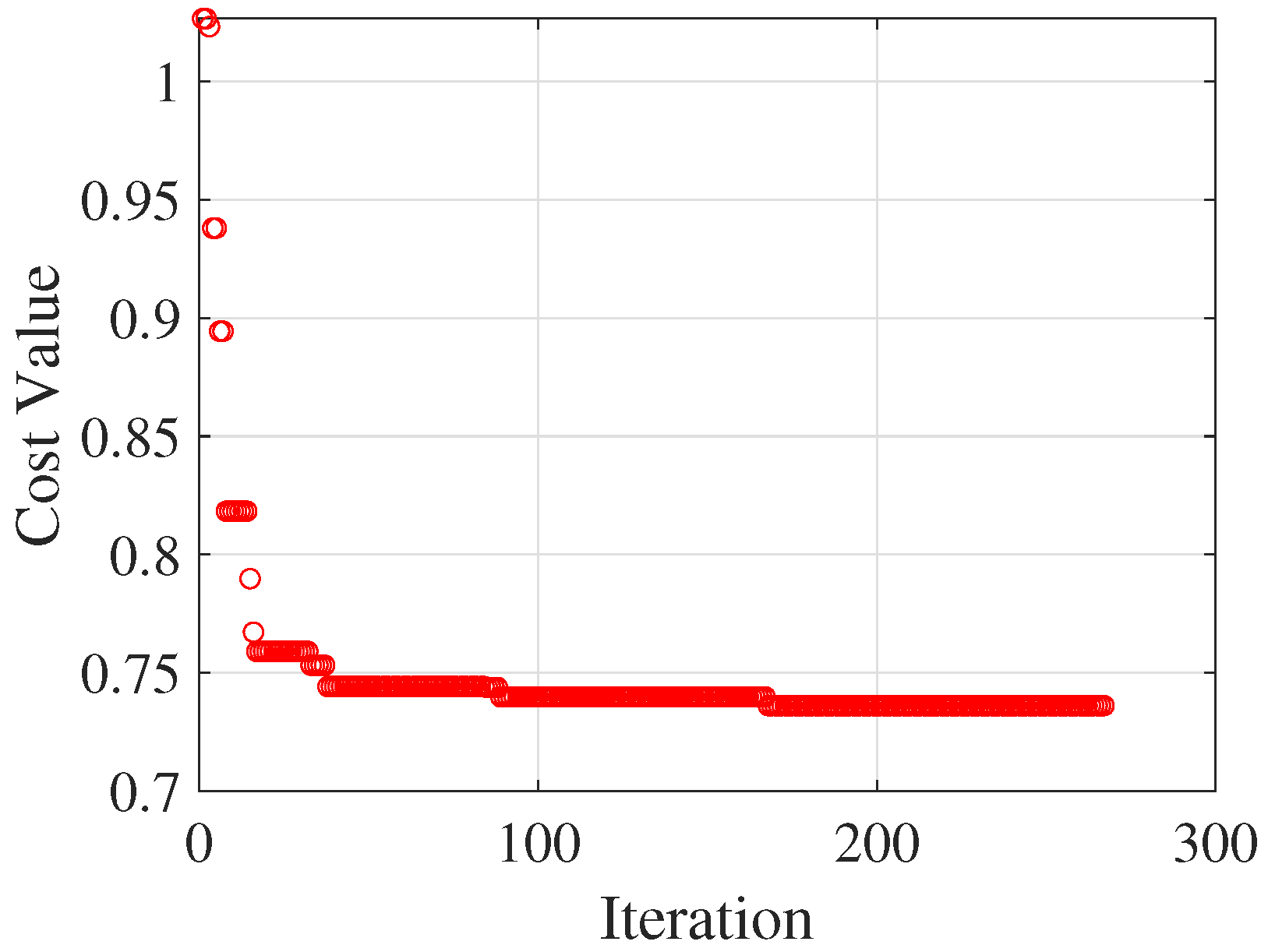
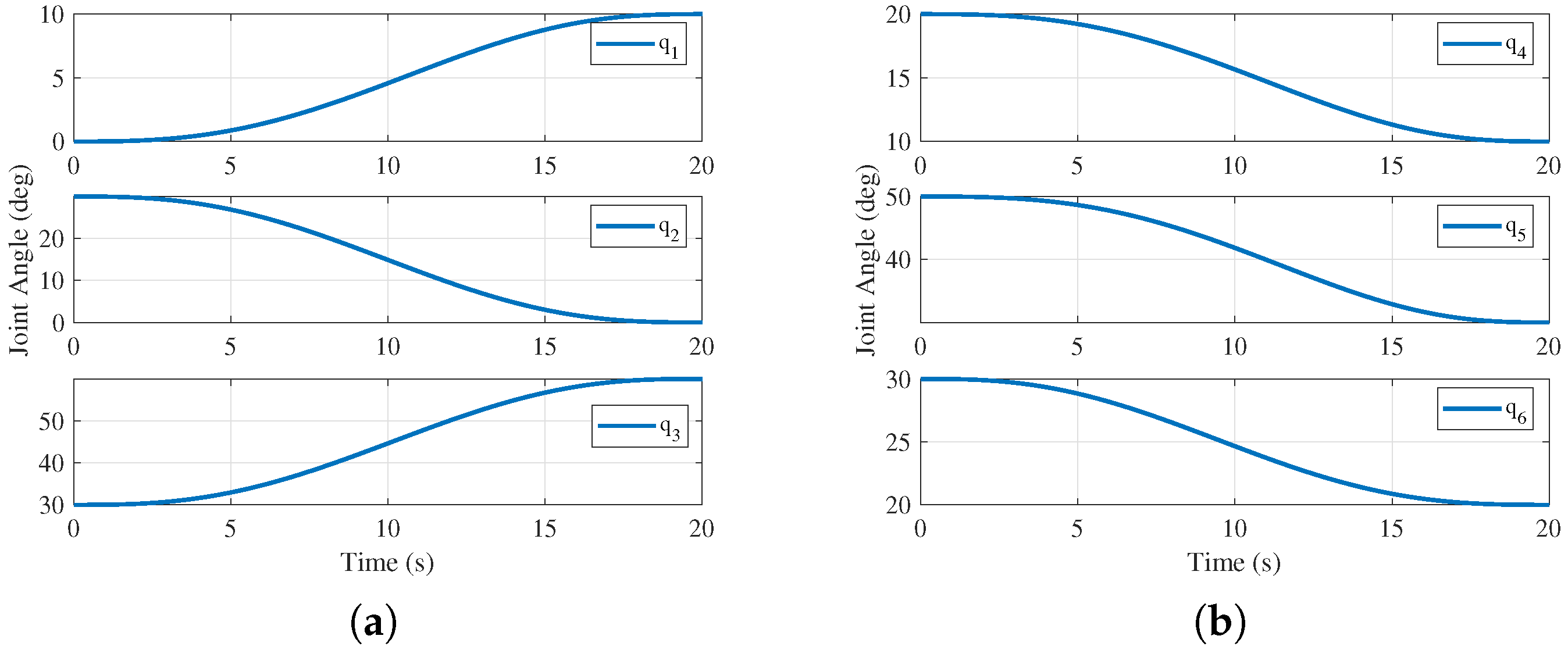
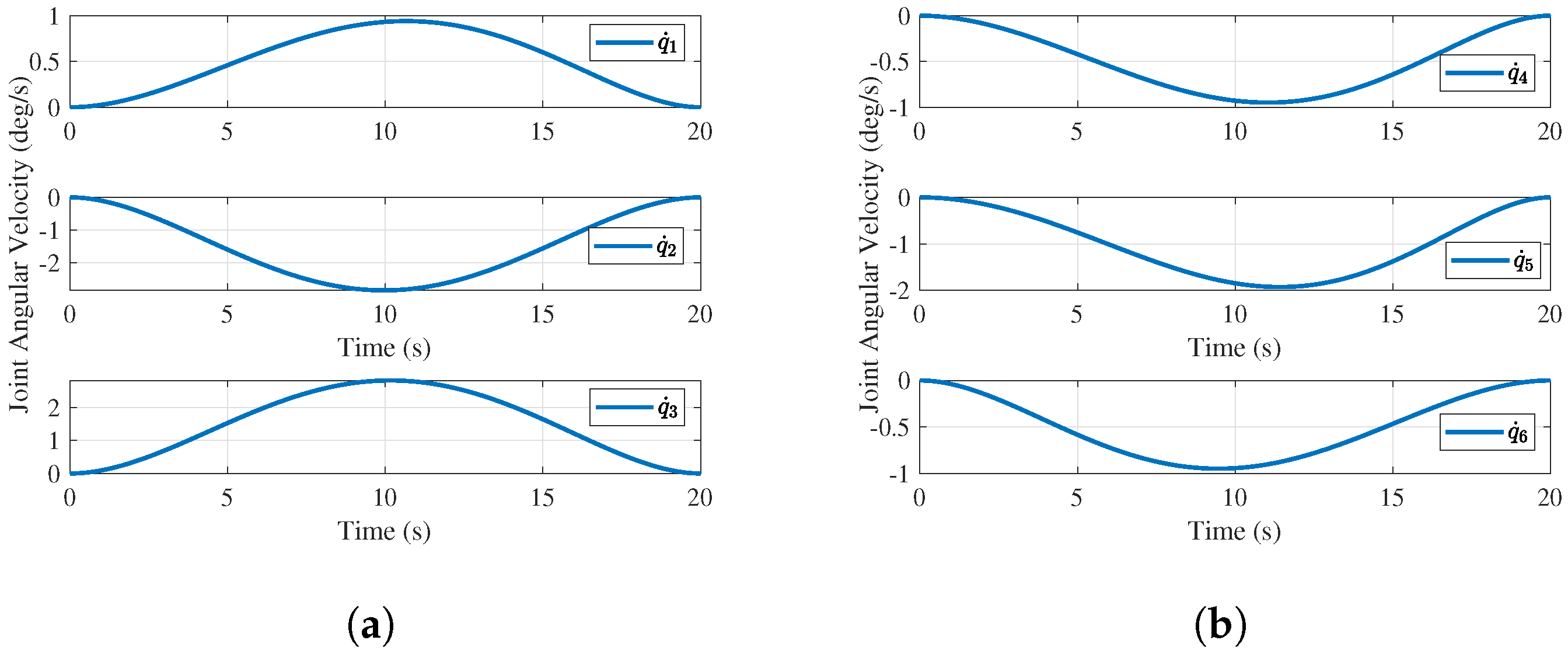
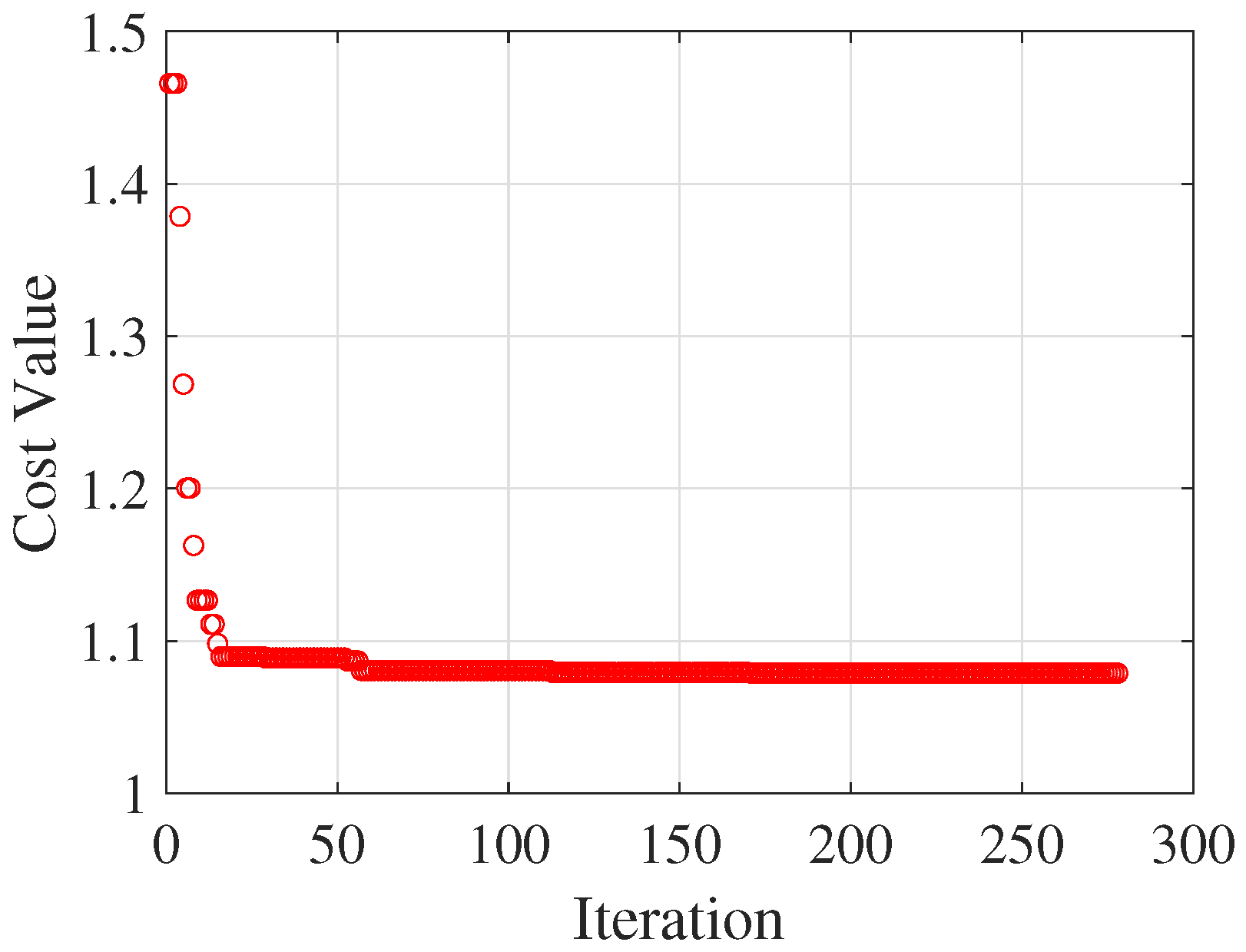
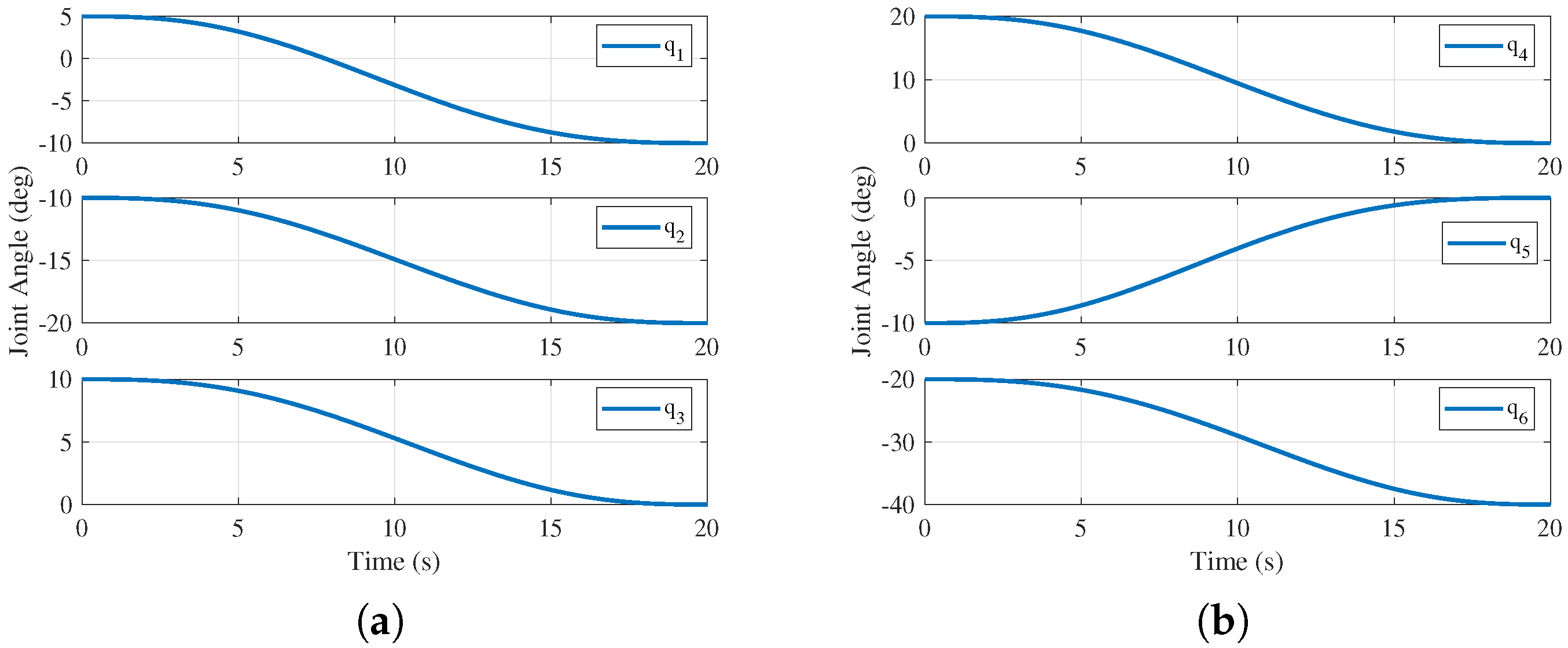
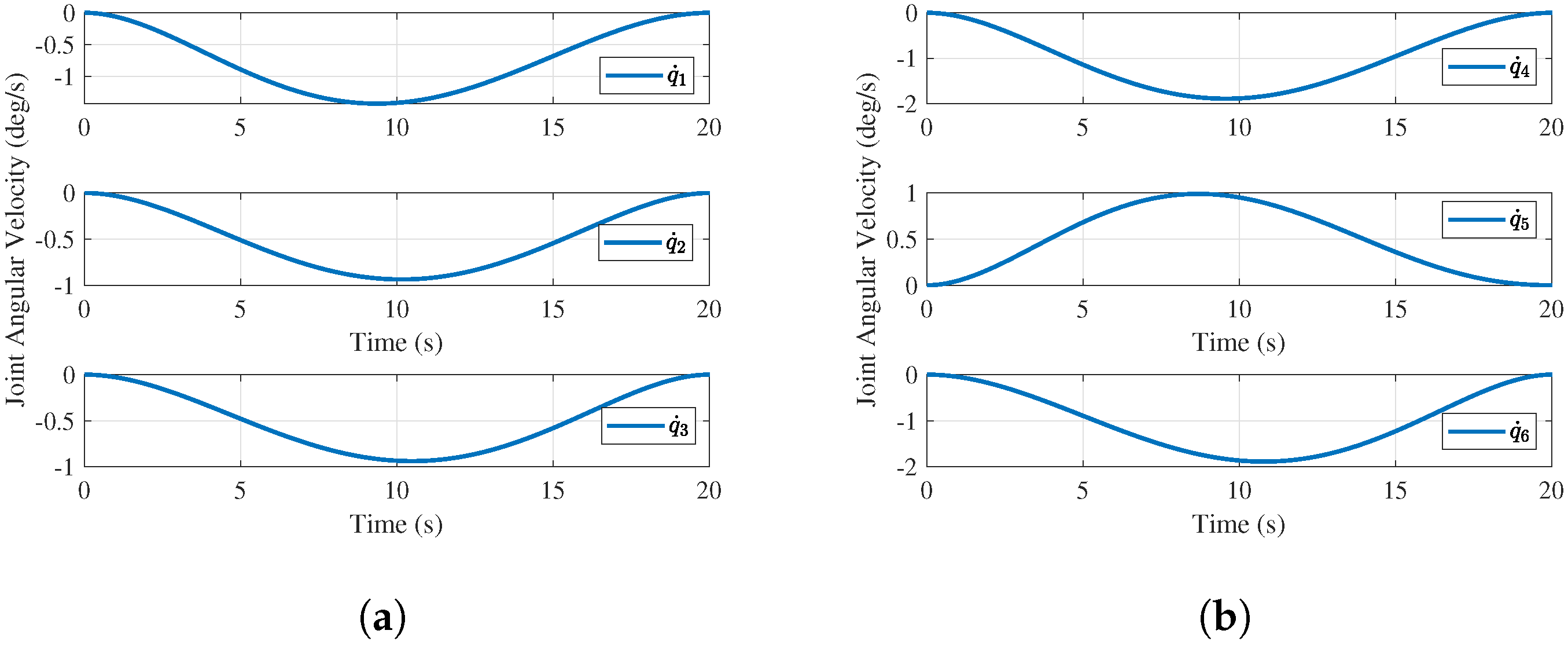
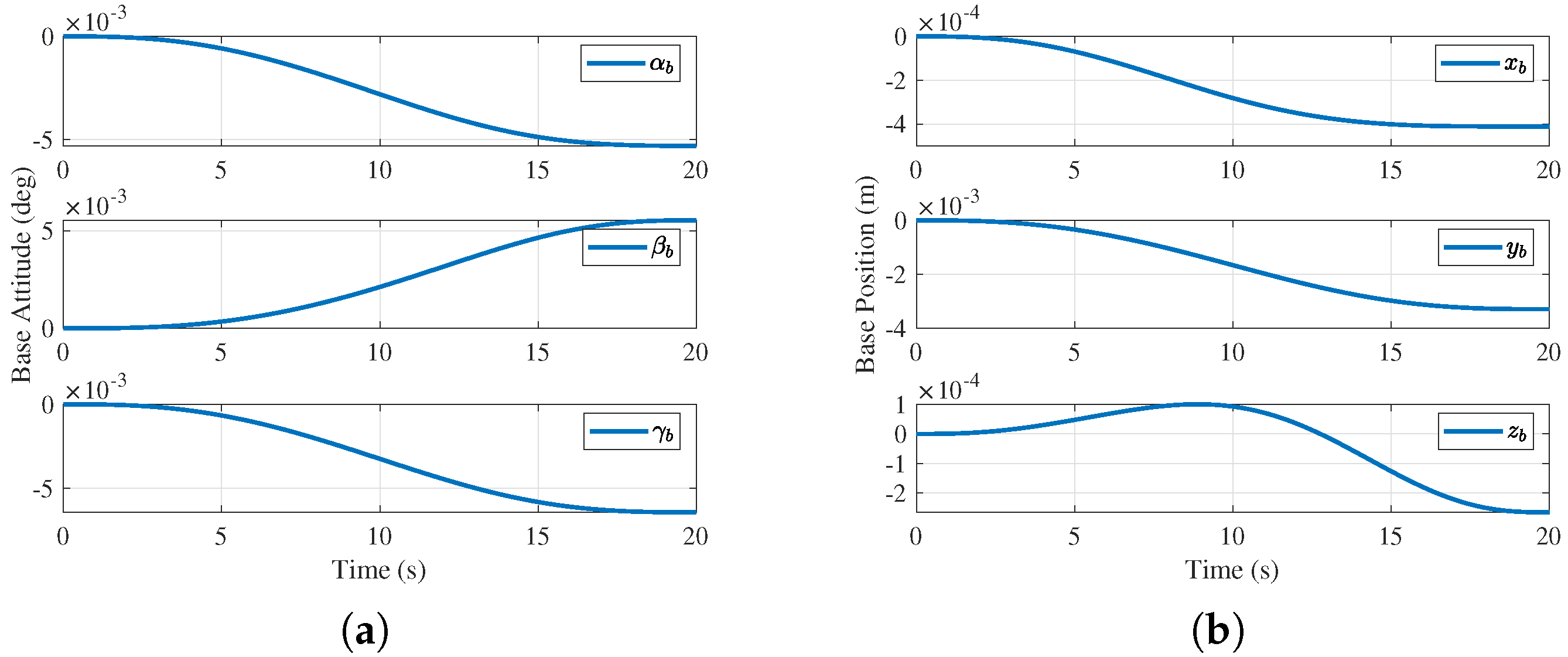

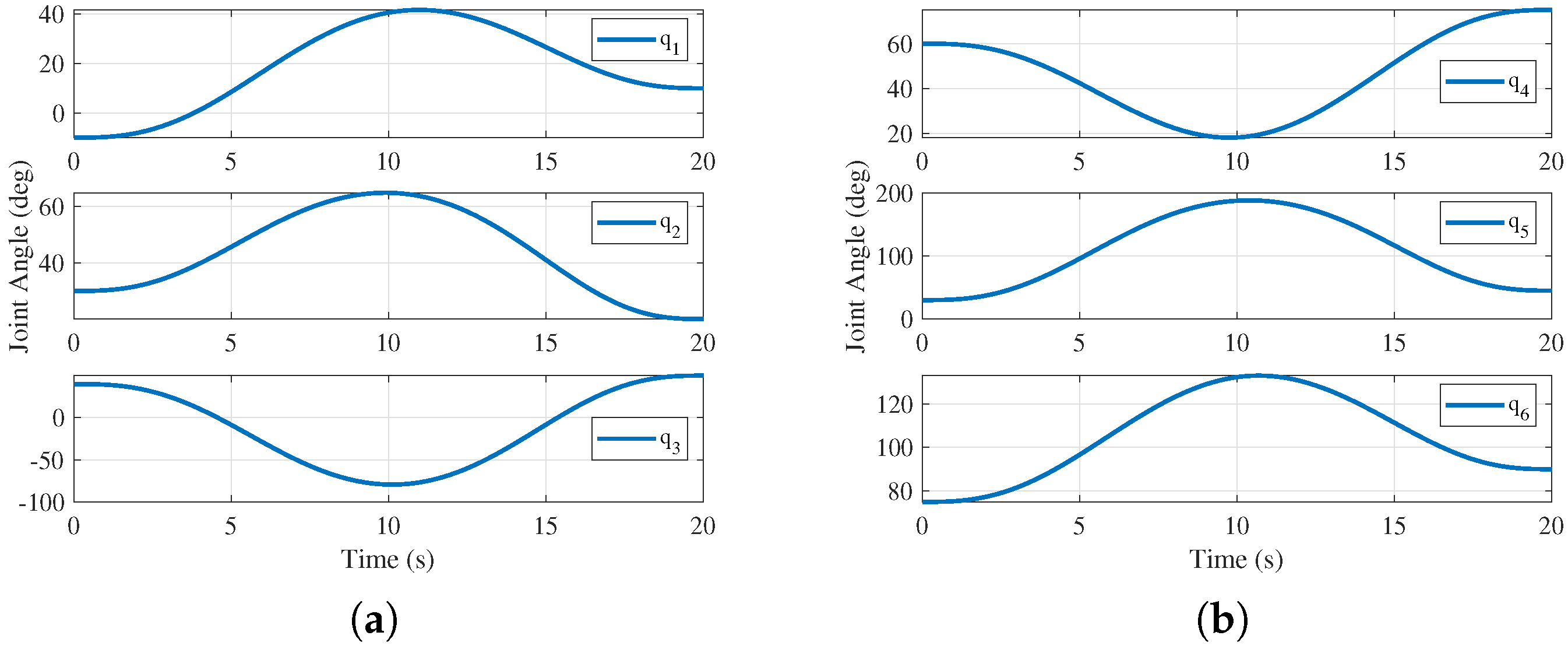


| Symbol | Representation |
|---|---|
| Center of mass of AEROM system | |
| (i= 0, …, n) | Body i, where denotes UAV base and (i= 1, …, n) denotes ith link of robotic manipulator |
| (i= 0, …, n) | Center of mass of |
| (i= 0, …, n) | Joint i, connecting and |
| (i= 1, …, n) | Vector from to |
| (i= 0, …, n) | Vector from to |
| (i= 0, …, n) | Position of in inertial coordinate system |
| (i= 1, …, n) | Position of in inertial coordinate system |
| Position of in inertial coordinate system | |
| Position of end effector in inertial coordinate system | |
| (i= 0, …, n) | Coordinate system established in with origin , axes , and |
| Inertial coordinate system with origin , axes , and | |
| Coordinate system established in end effector, with origin , axes , and |
| Mass (kg) | (kg) | (kg) | (kg) | (kg) | (kg) | (kg) | |
|---|---|---|---|---|---|---|---|
| UAV base | 80 | 44 | 0.3 | 0.4 | 43 | 0.3 | 26 |
| Link 1 | 1.5 | ||||||
| Link 2 | 1.1 | ||||||
| Link 3 | 1.5 | ||||||
| Link 4 | 1.0 | ||||||
| Link 5 | 1.5 | ||||||
| Link 6 | 4.0 |
Publisher’s Note: MDPI stays neutral with regard to jurisdictional claims in published maps and institutional affiliations. |
© 2022 by the authors. Licensee MDPI, Basel, Switzerland. This article is an open access article distributed under the terms and conditions of the Creative Commons Attribution (CC BY) license (https://creativecommons.org/licenses/by/4.0/).
Share and Cite
Zhao, S.; Chen, C.; Li, J.; Gao, S.; Guo, X. Trajectory Planning of Aerial Robotic Manipulator Using Hybrid Particle Swarm Optimization. Appl. Sci. 2022, 12, 10892. https://doi.org/10.3390/app122110892
Zhao S, Chen C, Li J, Gao S, Guo X. Trajectory Planning of Aerial Robotic Manipulator Using Hybrid Particle Swarm Optimization. Applied Sciences. 2022; 12(21):10892. https://doi.org/10.3390/app122110892
Chicago/Turabian StyleZhao, Suping, Chaobo Chen, Jichao Li, Song Gao, and Xinxin Guo. 2022. "Trajectory Planning of Aerial Robotic Manipulator Using Hybrid Particle Swarm Optimization" Applied Sciences 12, no. 21: 10892. https://doi.org/10.3390/app122110892
APA StyleZhao, S., Chen, C., Li, J., Gao, S., & Guo, X. (2022). Trajectory Planning of Aerial Robotic Manipulator Using Hybrid Particle Swarm Optimization. Applied Sciences, 12(21), 10892. https://doi.org/10.3390/app122110892







